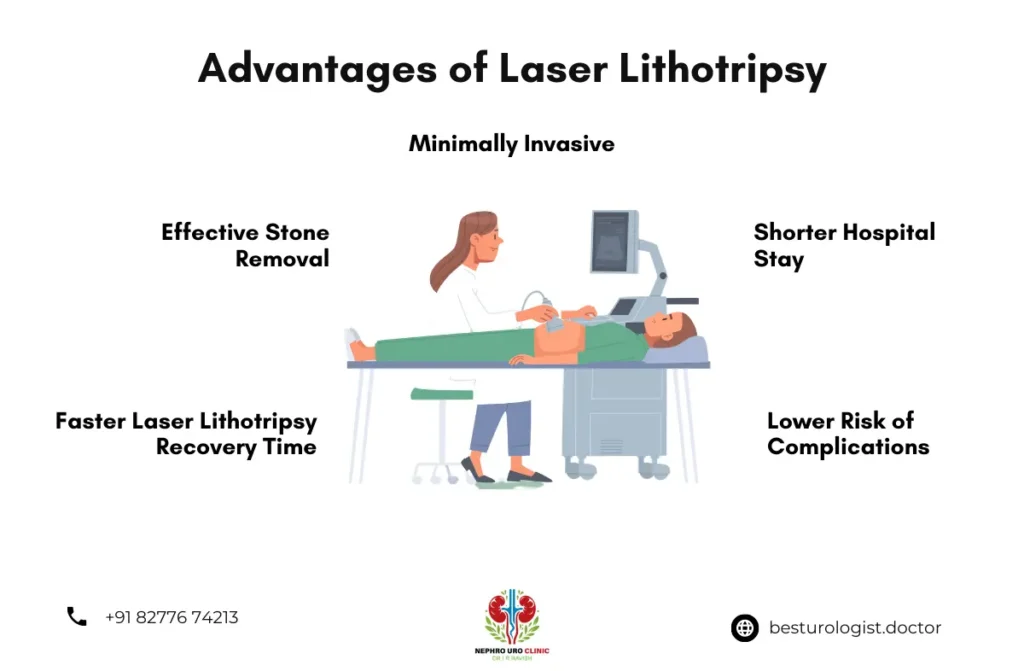Laser lithotripsy recovery time is an important concern for anyone undergoing this procedure. Understanding the healing process can help patients prepare for what lies ahead. As the Best Urologist, I ensure my patients receive the best care possible during their recovery. In this guide, we will explore what laser lithotripsy is, its benefits, risks, and what to expect post-procedure. Laser lithotripsy recovery time varies from patient to patient, but proper preparation and post-operative care can significantly impact the healing process.
What is Laser Lithotripsy?
Laser lithotripsy is a medical procedure used to break down kidney stones into smaller fragments using a laser. This treatment is performed through a minimally invasive method, reducing the need for open surgery. It is especially effective for stones that are too large to pass naturally or are causing pain and blockage in the urinary tract. Laser lithotripsy recovery time depends on the size of the stones and the patient’s overall health.
What Happens Before Laser Lithotripsy?
Before undergoing laser lithotripsy, the patient will need a thorough medical evaluation, including imaging tests like X-rays or CT scans to locate the kidney stones. The doctor may also recommend stopping certain medications that can affect bleeding. Patients are typically advised to fast for a few hours before the procedure. Preparing properly helps ensure a smoother laser lithotripsy recovery time.

What is Ureteroscopy with Holmium Laser Lithotripsy?
Ureteroscopy with holmium laser lithotripsy is a specialized form of laser lithotripsy that uses a flexible ureteroscope to reach the stones. The holmium laser effectively fragments the stones into tiny pieces that can be passed naturally or removed using a special basket. This method is widely preferred for its high success rate and minimal side effects.
What are the Advantages of Laser Lithotripsy?
- Minimally Invasive: No large incisions are required, leading to quicker healing.
- Effective Stone Removal: The laser breaks stones into tiny fragments that can be easily passed.
- Shorter Hospital Stay: Most patients can go home the same day.
- Lower Risk of Complications: Compared to traditional surgery, laser lithotripsy has fewer risks.
- Faster Laser Lithotripsy Recovery Time: Patients typically resume normal activities within a few days.
What are the Risks of Laser Lithotripsy?
- Mild Discomfort: Patients may experience some pain during urination.
- Bleeding: Small amounts of blood in urine are common but usually temporary.
- Infection: In rare cases, antibiotics may be needed to prevent infection.
- Ureteral Injury: Although rare, there is a slight risk of damage to the ureter.
- Prolonged Recovery Time for Ureteroscopy with Laser Lithotripsy: Some patients may take longer to heal depending on their condition.
What is the Recovery Time for Laser Lithotripsy?
The recovery time for laser lithotripsy varies depending on the size of the stones and individual health conditions. Generally, most patients can resume normal activities within 48 hours, while complete recovery may take about one to two weeks. Staying hydrated and following post-procedure guidelines can speed up the healing process. Recovery time for ureteroscopy with laser lithotripsy also depends on whether a stent was placed during the procedure.
The Benefits of Laser Lithotripsy
- Quick Recovery: Most patients experience minimal downtime.
- High Success Rate: It effectively removes stones with fewer complications.
- Reduced Pain: Compared to other treatments, the pain level is much lower.
- Outpatient Procedure: Most cases do not require hospitalization.
- Predictable Recovery Time for Ureteroscopy with Laser Lithotripsy: Most patients recover fully within a couple of weeks.
Why is Ureteroscopy with Laser Lithotripsy Needed?
Ureteroscopy with holmium laser lithotripsy is needed when kidney stones become too large to pass naturally or cause severe symptoms. Patients experiencing persistent pain, urinary blockage, or recurrent infections benefit greatly from this procedure. This treatment ensures a safer and faster laser lithotripsy recovery time.
How to Prepare for Ureteroscopy with Holmium Laser Lithotripsy?
- Medical Assessment: A detailed evaluation helps determine the best treatment plan.
- Fasting Requirement: Patients may be required to fast for 6-8 hours before surgery.
- Medication Adjustments: Blood thinners and other medications might need to be stopped.
- Hydration: Drinking plenty of water helps flush out fragments post-surgery.
- Following Instructions for Faster Recovery Time for Ureteroscopy with Laser Lithotripsy: Proper preparation reduces complications.
What is the Procedure for Ureteroscopy with Holmium Laser Lithotripsy?
During ureteroscopy with holmium laser lithotripsy, a thin tube with a camera (ureteroscope) is inserted into the urinary tract. The laser then shatters the stones, allowing them to be passed naturally or removed using a small basket.
What are the Side Effects of Ureteroscopy with Holmium Laser Lithotripsy?
- Temporary Discomfort: Mild pain and burning sensation during urination.
- Frequent Urination: Common for a few days post-procedure.
- Blood in Urine: Usually resolves within 24-48 hours.
- Mild Swelling: The ureter may swell slightly, causing temporary discomfort.
- Understanding What to Expect After Ureteroscopy with Laser Lithotripsy: Recovery varies for each patient.
What are the Risks of Ureteroscopy with Holmium Laser Lithotripsy?
- Infection: Rare, but can occur if proper hygiene is not maintained.
- Ureteral Damage: Small risk of injury to the urinary tract.
- Incomplete Stone Removal: In some cases, a follow-up procedure might be needed.
- Longer Recovery Time for Ureteroscopy with Laser Lithotripsy: Some patients take longer to heal.
What is the procedure for Ureteroscopy with Laser Lithotripsy?
What is ureteroscopy with laser lithotripsy? Ureteroscopy with laser lithotripsy is a minimally invasive procedure. It begins with the administration of anesthesia, either general or local, depending on the patient’s health and preference. A thin, flexible tube (ureteroscope) is inserted through the urethra and guided into the bladder and ureter. Once the stone is located, a laser fiber is passed through the ureteroscope to direct the laser energy at the stone. The laser breaks the stone into smaller fragments, which are then either passed through the urine or removed by the doctor.
What is laser lithotripsy? This procedure is typically performed on an outpatient basis, meaning patients can usually go home the same day. The recovery time is quick, and many people are able to return to normal activities within a few days.
What Can I Expect After Ureteroscopy with Laser Lithotripsy?
what is ureteroscopy with laser lithotripsy, you may experience some discomfort, but this usually resolves within a few days. Common post-procedure symptoms include:
- A burning sensation while urinating.
- Blood in the urine, which should gradually improve over time.
- Mild cramping or soreness in the lower abdomen.
You will likely be prescribed pain relief medications to help manage any discomfort. It’s essential to drink plenty of water to help flush out the remaining stone fragments and prevent new stones from forming.
ureteroscopy with laser lithotripsy female is especially useful for treating kidney stones that are difficult to reach or too large to pass naturally. This minimally invasive procedure uses a thin tube (ureteroscope) and laser to break down the stones, offering a faster recovery and less discomfort compared to traditional surgery
What Are the Side Effects of Ureteroscopy with Laser Lithotripsy?
ureteroscopy with laser lithotripsy complications may occur along with significant symptoms. Possible side effects include:
- Mild bleeding or blood in the urine.
- Urinary tract infections (UTIs) in some cases.
- A slight risk of injury to the ureter during the procedure.
It’s important to follow post-procedure instructions carefully to minimize the risk of side effects. What is laser lithotripsy? It is a highly effective treatment that uses a laser to break kidney stones into smaller fragments.
What Are the Risks of Ureteroscopy with Laser Lithotripsy?
Like any medical procedure, ureteroscopy with laser lithotripsy complications carries some risks, although serious complications are rare. Potential risks include:
- Injury to the Ureter or Surrounding Organs: Rare, but possible injury to the ureter or nearby organs.
- Infection: May occur and require antibiotics.
- Urinary Retention or Difficulty: Some patients may experience difficulty urinating after the procedure.
- Fragmented Stone Pieces: Small fragments of the stone may become lodged in the ureter.
The risks are low, and the procedure is safe. What is laser lithotripsy? It’s a minimally invasive procedure using a laser to break down kidney stones
Are There Alternatives to Laser Lithotripsy?
Yes, alternatives include:
- Extracorporeal Shock Wave Lithotripsy (ESWL): Uses shock waves to break stones.
- Percutaneous Nephrolithotomy (PCNL): A more invasive procedure for large stones.
- Medication Therapy: Some small stones can be managed with medications.
- Different Recovery Expectations Compared to What to Expect After Ureteroscopy with Laser Lithotripsy: Alternative treatments may have different recovery timelines.
What to Expect After Ureteroscopy with Laser Lithotripsy?
Patients can expect mild discomfort for a few days. Drinking water helps flush out stone fragments. A follow-up visit may be needed to ensure all stones are removed. It is normal to have some blood in urine and frequent urination for a short period. Knowing what to expect after ureteroscopy with laser lithotripsy can help ease recovery concerns.
Conclusion
Laser lithotripsy recovery time is generally short, allowing patients to return to normal activities quickly. As the Best Urologist, I ensure that every patient receives personalized care and support throughout their recovery. If you have any questions or need further guidance, feel free to reach out. Understanding ureteroscopy with laser lithotripsy female can help you prepare better for the procedure and ensure a smooth healing process.
Read also Complications of a Vasectomy.






